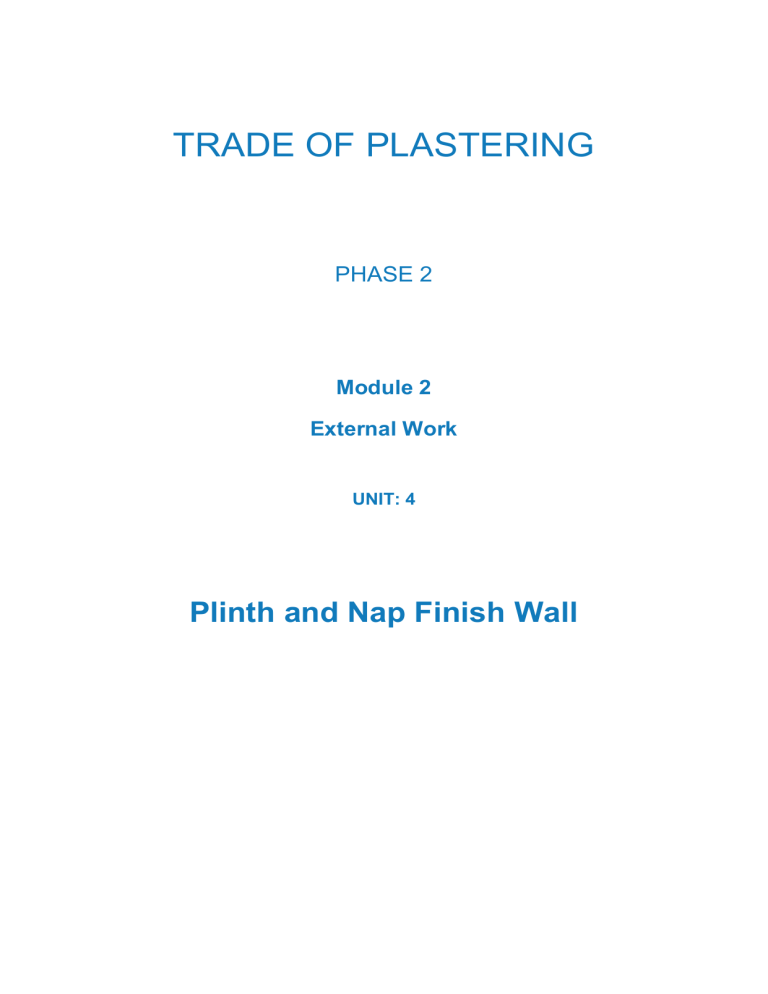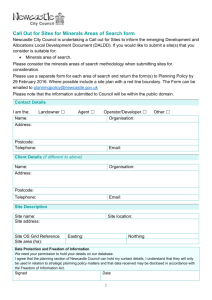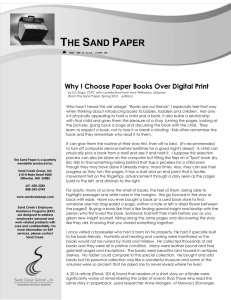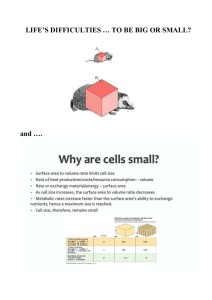Unit Objective

TRADE OF PLASTERING
PHASE 2
Module 2
External Work
UNIT: 4
Plinth and Nap Finish Wall
Module 2– Unit 4
Produced by
Plinth and Nap Finish Wall
In cooperation with subject matter expert:
Terry Egan
Some images & text courtesy of Gypsum Industries Ltd.
© SOLAS
Plastering Phase 2 Revision 2.0 January 2014
Module 2– Unit 4 Plinth and Nap Finish Wall
Table of Contents
Introduction .................................................................................................................. 1
Unit Objective .............................................................................................................. 1
1.0
Estimate and Calculate Volumes .................................................................. 2
1.1
Estimation and Calculation of the Volume of Materials....................... 2
1.2
Costing of Materials .................................................................................... 5
Plastering Phase 2 Revision 2.0 January 2014
Module 2– Unit 4 Plinth and Nap Finish Wall
Introduction
Welcome to this section of your course which is designed to introduce you, the learner, to volumes.
Unit Objective
By the end of this unit each apprentice will be able to:
Estimate and calculate volumes
Plastering Phase 2
1
Revision 2.0 January 2014
Module 2– Unit 4 Plinth and Nap Finish Wall
1.0 Estimate and Calculate Volumes
Key Learning Points
Estimation and calculation of the volume of materials per square metre
Costing of materials
1.1 Estimation and Calculation of the Volume of Materials
Volumes
When the sand is mixed with water and cement, although you might assume the total volume would be increased, the opposite in fact occurs. This is because the sand is no longer in a loose, dry condition. All the voids in the sand will be filled with cement and water, making the sand more compact.
You can carry out a simple test to prove this, with a jar of dry sand. Fill the dry sand right to the top of the jar. Then tip the sand out and mix it with water. Put the wet mixture back into the jar. You will find that the mixture is now about
30 per cent less in volume than it was in a dry condition. This then tells us that although 1 cubic metre of dry sand will cover 20 square metres at 50 mm thickness, 1 cubic metre of wet sand will cover about 30 per cent less area. Or,
20 square metres less 30 per cent = 14 square metres.
If the floor to be laid is only 25 mm in thickness, then the area of floor that can be laid with 1 cubic metre of sand will be 28 square metres.
The same applies to sand and cement floating coats, which will be at a normal maximum of 12-13 mm. This will be half the thickness again, thus giving 56+ square metres of floating to 1 cubic metre of sand. Once you have remembered these basic figures, you should find it easy to calculate for work at other thicknesses. On some small jobs you may find that you can easily assess that you will require, say, 4 or 5 barrows of sand to carry out the work. This will represent about half a cubic metre of sand, for you will find that there are up to
10 barrows of sand to 1 cubic metre. Merchants who supply their sand by weight will do any conversions for you if you order by the cubic metre.
Covering Capacity of Sand
Not all plastering materials are delivered in 50-kilo bags, the main exception being sand. You may find that working out the covering capacity of sand is a little more difficult.
Plastering Phase 2
2
Revision 2.0 January 2014
Module 2– Unit 4 Plinth and Nap Finish Wall
Sand is sold either by the tonne or by the cubic metre (m) as an approximate guide 1m of sand weighs 2 tonnes. Before sand is mixed with cement and water, it will be of a loose nature and, if spread out will cover a greater area that it will when wet. This is an important fact to remember and the reason has been given previously.
All calculations for sand requirements will need to be worked out in cubic metres (m). A cubic metre is a cube 1m × 1m at its base, and 1m high. Of course, sand will not be delivered in this form but, to calculate your requirements, it is necessary to consider it in this way.
Let us take an example. We will assume that we are laying floor screeds at a thickness of 50mm. Now we can draw a cube to represent 1 cubic metre. If we divide the cube into layers 50mm thick, we can see that in the height of the cube we have 20 layers. This tells us that 1 cubic metre of sand, if spread out at
50mm thickness will cover 20 square metres in area.
Plastering Phase 2
3
Revision 2.0 January 2014
Module 2– Unit 4 Plinth and Nap Finish Wall
Volumes of Concrete
The amount of concrete required for any project such as foundations, lintols, paths, floors, etc., can normally be calculated from the formula, Volume =
Length × Breadth × Depth.
Different formulae apply to unusual shapes, such as circular columns, triangular sections.
It is important to carry out all calculations, except for very small quantities, in cubic metres (m³), and therefore where the length, breadth or depth is given in millimetres it must be converted to metres before commencement.
For example, to multiply 5m×100mm × 50mm, the figures would be
5×0.1×0.05; the result would be in m³.
Examples:
1.
A strip foundation for a garden wall is 12.5m long, 600mm wide and
150mm thick.
Calculate the volume:
Volume = Length × Breadth × Depth.
= 12.5 × 0.6 × 0.15
= 7.5 × 0.15
= 1.125m³
2.
A concrete path is 6.4m long, 950mm wide, 60mm thick. Calculate the volume.
Volume = Length×Breadth×Depth
= 6.4×0.95×0.06
= 6.08×0.05
= 0.3648m³
Plastering Phase 2
4
Revision 2.0 January 2014
Module 2– Unit 4 Plinth and Nap Finish Wall
3.
A concrete lintol is 1.2m long, 100mm wide and 150mm deep. Calculate the volume.
Volume = Length×Breadth×Depth
= 1.2×0.15×0.1
= 0.18×0.1
= 0.018m³
Exercise:
Shown below is a sketch of a regular shaped solid. Calculate the volume of the solid.
1.2 Costing of Materials
Principles of Pricing
Pricing for plastering can be done in two ways:
1.
Pricing for only supplying labour, with the materials being supplied by the builder or client. This is known as ‘Labour Only’.
2.
Pricing for supplying both labour and materials required. This is known as ‘Labour and Materials’.
Even if you are pricing labour only, the client may ask you to let him have a list of materials required. As you can see, it is essential for you to have a good knowledge of all areas practical calculations.
Plastering Phase 2
5
Revision 2.0 January 2014
Module 2– Unit 4 Plinth and Nap Finish Wall
Amount of Materials Required
To calculate the amount of materials required, you will need to know the covering capacity of different materials. That is to say, how many square metres of work can be covered with a bag of plaster? If you go to your local builders' merchants they will supply you with a Plaster Selector Guide. Not only will this advise you on suitable plasters for different backgrounds, but will also list the covering capacities of the different plasters.
The covering capacity will be given as the amount of work that can be covered by one tonne of material. This need not cause any confusion. You will need to know that there are 1000 kilos to 1 tonne. There are 20 bags of plaster to 1 tonne. Therefore each bag weighs 50 kilos (1000 ÷ 20 = 50).
Using the Plaster Selector Guide, we can show some examples. Floating coat is stated as covering 117m² per 1000 kilos. An average figure will be 117m² per
1000 kilos (1 tonne); so if 117 is divided by 33, we can see that one 30 kilo bag will cover 3.54m² of wall area.
Plastering Phase 2
6
Revision 2.0 January 2014
27-33 Upper Baggot Street
Dublin 4









